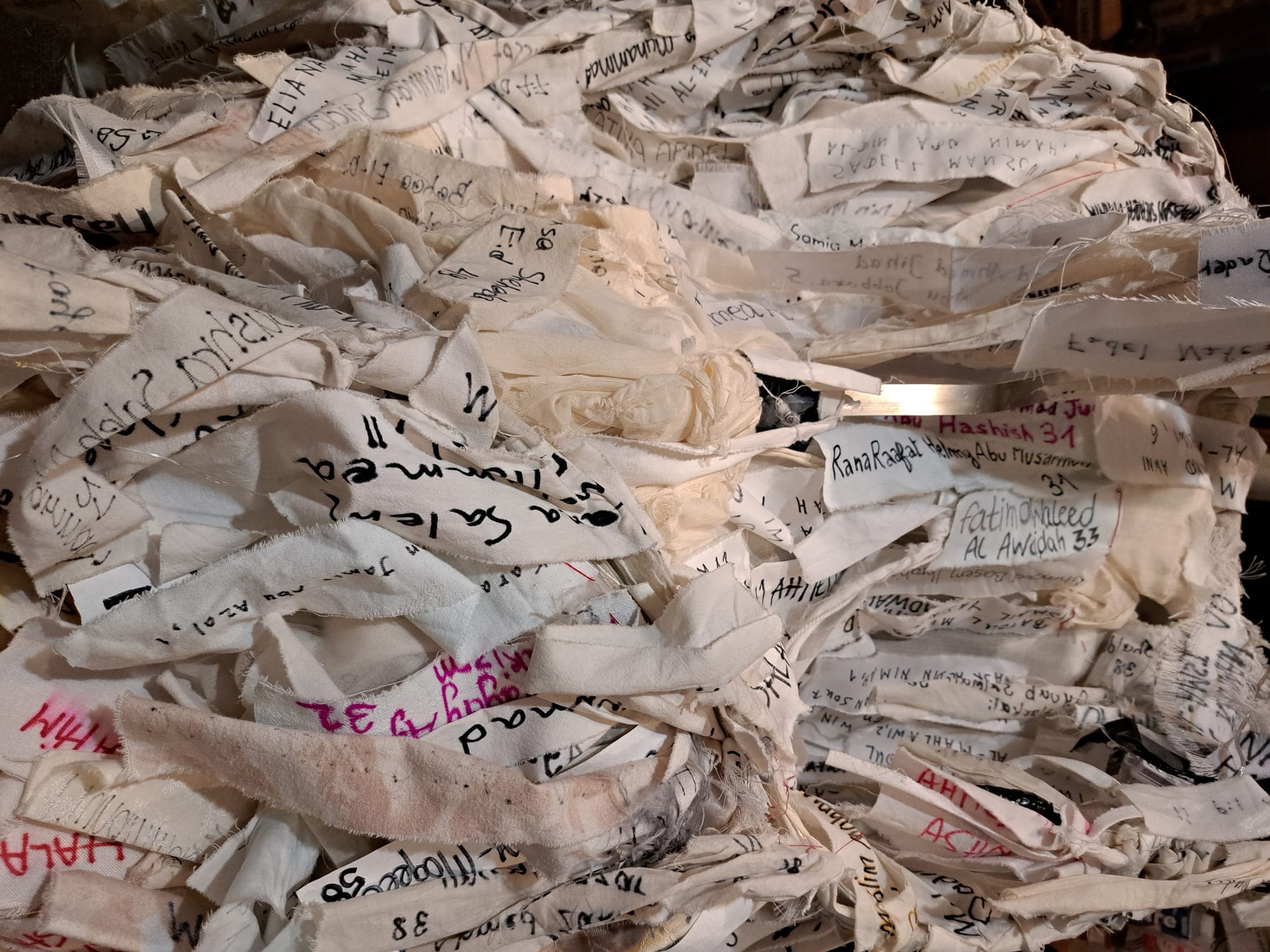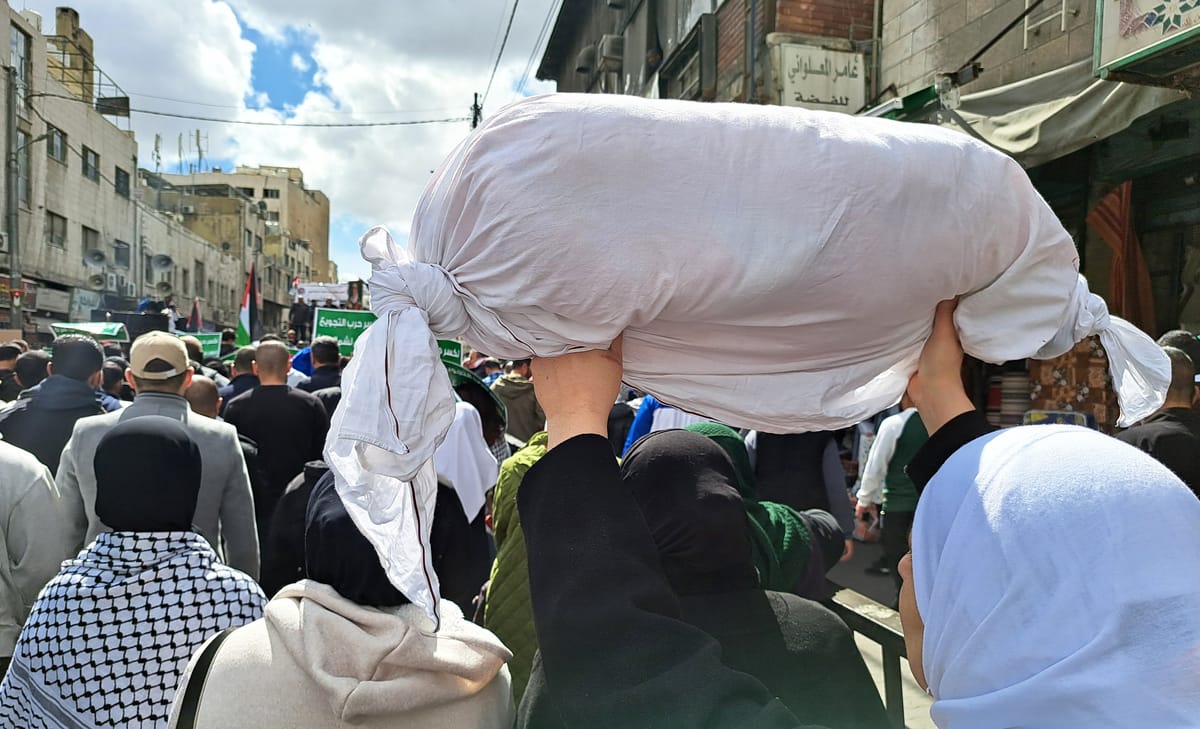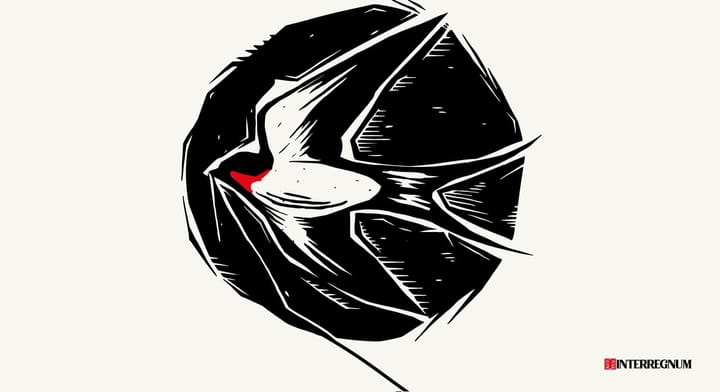Siraj Izhar explores the colonial imagination that drives the genocide in Gaza, and what underlies our difficulties of confronting it.
By Siraj Izhar
Whatever the contentions on the term we use to express the scale and method of killing we are witnessing in Gaza, the description at the International Court of Justice as a 'live-streamed genocide' is both apt and particular to our age. For this is no 20th-century genocide we hear of through whispered rumours. Instead, the intent, the process, the structure, and the scale of the killing has almost been too transparent for us. It is a theatre of a mass killing at which we are all present. A theatre of death foretold, as in Refaat Alareer's If I must die, to be circulated virally on apps like Instagram, TikTok, Twitter. It's where we hear the voice of a 6-year-old girl asking for an ambulance to come. We see her face. Then we see the images of a burnt ambulance, followed by the confirmation of her death, alongside that of the medics who answered her call. We see women and infants being pulled out of the rubble with bare hands, which is the way loved ones must be dug out. We read the lines of the poet Hiba Abu Nada on Twitter:
Our family photos, a bag of limbs, a pile of ash, five wrapped shrouds....
And then she's dead herself, in an Israeli bombing raid, as if to follow her own lines:
Entire family trees have fallen, not people nor branches.
When death can be telegraphed on social media to this scale by those in fear, a shared trauma builds up, to be mirrored by a collective helplessness across global networks. Week after week, it is indeed a theatre of a live-streamed genocide. A theatre where helplessness is accompanied by an incomprehension as to why the actors of international governance like the UN, for all their endeavours, cannot bring an end to it.
The reasons lie in the historical incongruity of what we do not see in the transparency of social media: an incongruity rooted in the specificity of death which, until recently, was absented a place in history. This is an incongruity of death as a colonial death that predates the instruments of international law like the UN or the ICJ (International Court of Justice), and which, by the nature of its origins, carries neither a requirement of naming, nor the burden of accountability. In this sense, the death in this genocide in Gaza, as it extends through the virtual space of social media networks, returns us to an unconcluded chapter of colonialism in another place: an imaginative geography where both the state of Israel and the enclosure of Gaza exist.
The term imaginative geography comes from Edward Said's study on Orientalism to describe the way that the colonial imagination could establish its space within the space of others, planting itself over the materiality of the realm through the force of its own narratives. Said focuses on the arbitrariness of this process. On how an exercise of the imaginative, the poetic, the fictional over the material and the objective becomes a system of representation for an ‘us’ and a ‘them’. On how a means of self-validation to address fantasies and phobias in the space of others comes to divide the material world between an ‘ours’ and a ‘theirs’, and carries with it a simultaneous distinction between the civilised, rational and peaceful (the ‘us’) and the uncivilised, emotional, and violent (the ‘them’). As Said shows, the imaginative geography is the means towards establishing a moral order where the ‘us’ can claim agency and exercise authority both on behalf of, and for the benefit of, the ‘them’; to quote Said, ‘It is enough for "us" to set up these boundaries in our own minds; "they" become "they" accordingly, and both their territory and their mentality are designated as different from "ours"’.
This is what we must bear in mind through any reading of this essay on the question of who has the claim to agency in the time of this genocide in Gaza – and, indeed, where that agency comes from. The aim is to help us understand the source of our sense of helplessness. And why the instruments of law and governance we turn to have no means of ending the killing in this theatre of genocide. It is as though there is a ruse of law that overrules the rule of law. A ruse of law as an imaginary power that eludes its naming but returns us to the sphere of imaginative geography – the place where the death in this genocide becomes purposive through its continuance, for that is how the imaginative geography renews itself. This is a renewal that takes place from year to year, decade to decade, century to century in the progress of colonial time through the distinction between the death of the us (to be defended) and the death of the them (to be disregarded).
Only our realisation of this process can help us understand the nature of the theatre of genocide we are in. The task of this essay is to explore these processes and illustrate the forces that animate them, in order to help us imagine a pathway beyond.
The colonial breach
I take the word ‘breach’ from China Miéville's The City and the City, a crime fiction novel set in a city with two names, Besźel and Ul Qoma. In this city, two different peoples live in the same place, yet in segregated realms of existence that are governed by a rule known as the ‘breach’. The word ‘breach’ becomes the shorthand in daily parlance that stands for what is inviolable and cannot be breached: the absolutism of the ‘breach’ in its rule of separation.
This is an absolutism that is made possible by the necessary practice of ‘unseeing’ naturalised into every aspect of life so that for an inhabitant of Ul Qoma, Besźel does not exist, and vice versa. And, when the rule of breach is absolute and inviolable, it also comes to determine what does and does not happen, what did and did not happen, depending on the place – inasmuch as someone from Besźel would say, ‘I unsaw it because it was in Ul Qoma’.
It is through mutations of such a rule of breach that we can read the evolution of the European project of a Zionist state in Palestine. I begin with the foreboding message expressed by Hannah Arendt in a letter to her husband in 1955, to be found in an anthology of her correspondence. In the current climate of repression, the letter has found broader circulation in the social networks:
From a political standpoint, things are even more hopeless than I thought. (...) The only time I ever saw anything like it but not to this extent, was in Germany. The galut-and-ghetto mentality is in full bloom. And the idiocy is right in front of everyone's eyes: Here in Jerusalem I can barely go for a walk, because I might turn the wrong corner and find myself "abroad," i.e., in Arab territory. Essentially it's the same everywhere. On top of that, they treat Arabs, those still here, in a way that in itself would be enough to rally the whole world against Israel.
Arendt connects Palestine with the native Germany she had fled from in 1933 through the ghettoised diasporic experience of the Jews in Europe. A Zionist, but with critical misgivings about a Zionist state, Arendt's letter contains the same omens as her essays, warning of a state whose founding condemns it to the inheritance and the establishment of the colonial relation in a sea of others. A state where the requirement of unseeing through a rule of breach, as a colonial breach, becomes one of necessity, if not of will. The only question lay in what shape and form it would take.
The way to bypass such a fate would have been through a project of expulsion and extermination; an operation that was attempted but was messy, incomplete, and ultimately unrealisable. An operation that left the state with the majority of those who had lived on its land for centuries still remaining on it in a stateless condition. So the state instead became a laboratory for new methods of colonial management. Which is why Miéville, writing in Guernica magazine on Palestine in 2013, almost 60 years after Arendt's letter, would express it in this way:
Yes, we know the holy land is now a land of holes, and lines, a freakshow of topography gone utterly and hideously mad, that the war against Palestinians is also a war against everyday life, against human space, a war waged with all expected hardware, with violent weaponized absurdism, with tons and tons of concrete and girders. This is truism, and/but true.
With the line this is truism, and/but true, Miéville is perhaps acknowledging the force of the other true, the one that overrides the reality he describes through a rule of breach that far exceeds his own imagination. A breach that not only separates people by the force of its rule, but one that absolves itself of the reality it produces. A form of breach realised on the ground that comes to exceed the breach in Miéville's novel, a breach freed for new dimensions of unseeing to make possible a project of colonial occupation and segregation in an endless status quo. A status quo that extends with support from the space it arose from – the imaginative geography of Europe – whose own narratives of memory and identity are in turn renewed. We can read this from this address by Ursula von der Leyen, the President of the European Commission, on the 26th of April 2023:
Today we also celebrate 75 years of friendship between Israel and Europe. We have more in common than geography would suggest: our shared culture, our values and hundreds of thousands of dual European-Israeli citizens have created a deep connection between us.
The address affirms Israel's place in the imaginative geography of Europe as a ‘vibrant democracy in the heart of the Middle East’, a democracy that has ‘made the desert bloom’, without a single word dedicated to the people in the same land, who are stateless and subject to walls and checkpoints, drones, blockades and mass imprisonment.
When unseeing elevated to such a scale of absolutism is inevitably fractured, as has happened in recent months, the struggle that it brings is not to address what the fracture exposes – the unseeing – but to find a language to correspond to the violation. A process that is encapsulated by the German phrase Zivilisationsbruch (breach of civilisation) in the narrative of its own self-authored genocides, to which it assigns a singularity of history and a project of memorialisation only to the one it enacted on its own soil on fellow Europeans. A Zivilisationsbruch that, following its barbarities, restores Germany's own place in the imaginative geography followed by relying on a self-prescribed ‘reason of state’ that it calls the Staatsräson.
Yet this is a Staatsräson that is now made dependent on another state, the state of Israel. It finds regular expression in German public affairs, as in this mid-October address by the chancellor, Olaf Scholz: ‘Israel's security is Germany's Staatsräson. Our own story, our responsibility of the Holocaust, makes it an everlasting task for the existence and security of the State of Israel’.
The Staatsräson has received critical scrutiny of late, particularly in terms of its use of collective guilt as an ideological tool. In effect, it serves as a rule of breach with its own sense of inviolability and its demand of unseeing. This unseeing prevents any recognition of the role of the Staatsräson itself in the unfolding project of dispossession and segregation in Palestine – for that would be akin to a violation of breach. This is why the unseeing must be protected by the state by all means necessary. And it explains why any expression of solidarity for what is exposed by the unfolding calamity in Gaza must be repressed using draconian force.

The return of the term Zivilisationsbruch from a prior genocide exemplifies the language of violation across the West and, ironically, both affirms and betrays the desperation of a project of repression and the continuation of the unseeing. The language of its predicament then (in the colonial quagmire of occupation and apartheid) could not be more distant from that of Ursula von der Leyen; which we see barely a few months later through the words of the lawyer and governmental advisor Daniel Seidemann in the Guardian: ‘Israel was a piece of broken pottery before October 7. The war has smashed things to smithereens’. The smithereens lay in the imaginative geography whose restoration becomes the only mission and only has one solution.
The colonial bind
In his short story Shooting an Elephant, George Orwell narrates a dilemma he finds himself in while stationed in Burma as an officer in the Indian Imperial Police. Though it is neither his will nor his judgement to kill an elephant, as the European holding the gun not to do so would irreparably break the image of the white man before the native.
Here was I, the white man with his gun, standing in front of the unarmed native crowd – seemingly the leading actor of the piece; but in reality I was only an absurd puppet pushed to and fro by the will of those yellow faces behind.
The yellow faces are those of the natives, the Burmese, who as the colonised have no capacity to act by themselves, but wait upon the white man. The white man who in turn believes that he is subject to their will as they watch his every movement.
This is the colonial bind. The bind that is binding as a form of colonial agency. The bind that becomes performative through a work of killing as a spectacle that the colonised, in their uncounted numbers, may watch. And yet at the same time, the colonial bind signifies the coloniser's own self-entrapment in its obligation to act on behalf of the colonised. It takes us back to Edward Said and the concept of imaginative geography through the forging of a moral order that frames its agency through an ‘us’ and a ‘them’. Because above all, the purpose of such a bind is to reassert the claim to that agency, with its ‘us’ and ‘them’.
To this end, through the genocide in Gaza, we come to see how vital the state of Israel has become to this claim of agency. A claim that repeatedly needs to assert who is part of the ‘us’: as with Joe Biden's use of the word 'ironclad' for the rationale of America's need for a state of Israel, or in Olaf Scholz's use of the Staatsräson. Thereon, we can see how the colonial bind becomes performative on the stage of world governance as Western leaders come and go from Israel: Joe Biden, Anthony Blinken, Emmanuel Macron, Olaf Scholz, Rishi Sunak, David Cameron, each one waving to the camera on touchdown. And each one, an emissary of the colonial bind, to enable a process of killing for which they commit more and more weapons. Meanwhile, the rest of the world may watch as they vainly appeal to the world courts and the UN to bring about a ceasefire.
And so, in addition to the annual support of $3 billion a year, the United States has to send $320 million worth of emergency arms to Israel in November, then another $106 million in December. These are for precision bomb kits and tens of thousands of tank shells. A few months later, a further $150 million worth of weaponry is sent in so-called 'under-the-radar' deliveries. And it's why the German government in tandem must increase its supply of weapons to Israel tenfold, with sales of over €300 million.
These weapons do the real work, the purposive work of the killing. But the colonial bind carries a measure to the scale of killing it involves, along with a scale of toleration. These we can read from history:
12 January 1904 – The Herero rebellion in Namibia against their dispossession by German colonisation, killing more than 100 German settlers. The response comes with a military order that states that ‘within the German borders every Herero, whether armed or unarmed, with or without cattle, will be shot’. What follows is a process of extermination and collective punishment, along with the German innovation of mass internment in concentration camps that leaves between 24,000 and 90,000 dead.
8 May 1945 – The Sétif and Guelma uprising in Algeria, killing 102 French colons (settlers). Vivid descriptions exist of the brutality of the massacres; the French colonial authorities and European settlers respond by slaughtering anything between 6,000 and 30,000 Algerians in defense of the stated goal to destroy the terrorists of the Front de Libération Nationale (FLN). A process that requires decades and multiplies the death toll, as the entire population of Algeria become synonymous with the FLN. The Journal of the school teacher Mouloud Feraoun records this as a testimony of the time:
We began by hitting low-level Muslim employees – those who most likely belonged to the FLN… Orders were given to hit all Muslims standing at bus stops who were wearing ties. We took them out [On les flinguait.]… The lads were very efficient [très opérationnels]… empty[ing] the European quarters of Muslims.
26 March 1953 – The Mau Mau in Kenya carry out the Lari massacre as recorded in the local police journal, killing about a hundred of the Kikuyu collaborationist Home Guard, including their children and elderly relatives, and in time some 30 White settlers. The British response is to massacre over 300,000 Kenyans in their declared aim to eradicate the Mau Mau, described as ‘an irrational force of evil, dominated by bestial impulses and influenced by world communism’.
This is the script of colonial retribution that needs referencing. The bear hug from Joe Biden to Benjamin Netanyahu was the signal to exact colonial retribution using the supply of weapons provided. Hence their operation in a latter-day AI- and algorithm-enhanced industrial killing operation, in an entrapped enclosure with its refugees once over from '48. The aim is to displace them, shuffling them several times in their enclosure, destroying most of their homes, every university, most hospitals and cultural centres.
Yet somehow, this is to be presented as the fulfillment of a mission enshrined in a line that every Western leader will repeat from an imagined altar. Israel has the right to defend itself – in essence the code for, We have the right... The right which, as George Orwell understood, will serve no purpose other than to be enacted to renew itself. This is the colonial bind for the coloniser, to be imposed upon the colonised, who have no option but to continue to struggle for their rights. This is a theatre of the bind that offers no way out. Which today takes us inevitably to Rafah, where the words from Miéville on Palestine are again prophetic.
No exit is marked. The arrows both point in. Straight towards each other. The logic of the worst dream. They beckon. They are for those who will always be outside, and they point the way to go. Palestine as plasma. Amorphous. Amoebal. Condensed. Women and men at point zero. Shrunken by weight, eaten and not digested. An infinite mass, in an infinitely small space.
Beyond the breach and the bind
At Rafah lies the pinhead of a narrative driving to its own dead-end in a cul de sac of killing. A theatre in which the institutions of international governance are present as the flag-bearers of the rule of law, with little agency.
A realisation of this is both necessary and liberative – which is the sole aim of this essay.
On the question of where it then leaves us in a time of genocide, perhaps we are seeing a place emerge, a place where our helplessness is forced into. A place where Palestine is de-territorialised in the virtual networks, in a space of transnational agency. A place built on the agency of tiny acts, consisting of simple sharing of media to large scale mobilisations of solidarity involving hundreds of thousands. For it is no hyperbole to say that we are witnessing an emergence of an unparalleled surge of global solidarity that comes from a place of a vast aggregated universal helplessness. Against which cascade upon cascade of repression follow, but too late. This emergence will run its course, so that we may come to see through our trauma with an end to the legacy of the imaginative geography that this genocide belongs to.
Siraj Izhar is an activist and artist working in autonomous spaces and informal networks. His projects are to be found at xyzlondon.com and his writings at amplife.org.






Comments ()